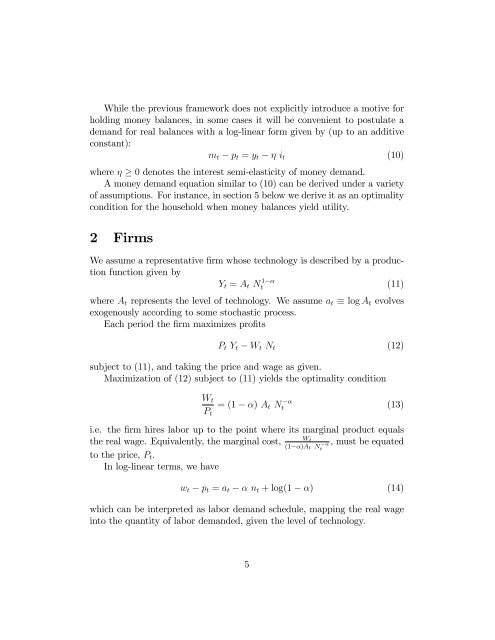Monetary Policy, Inflation, and the Business Cycle Chapter 2 A ...
Monetary Policy, Inflation, and the Business Cycle Chapter 2 A ...
Monetary Policy, Inflation, and the Business Cycle Chapter 2 A ...
You also want an ePaper? Increase the reach of your titles
YUMPU automatically turns print PDFs into web optimized ePapers that Google loves.
While <strong>the</strong> previous framework does not explicitly introduce a motive for<br />
holding money balances, in some cases it will be convenient to postulate a<br />
dem<strong>and</strong> for real balances with a log-linear form given by (up to an additive<br />
constant):<br />
m t p t = y t i t (10)<br />
where 0 denotes <strong>the</strong> interest semi-elasticity of money dem<strong>and</strong>.<br />
A money dem<strong>and</strong> equation similar to (10) can be derived under a variety<br />
of assumptions. For instance, in section 5 below we derive it as an optimality<br />
condition for <strong>the</strong> household when money balances yield utility.<br />
2 Firms<br />
We assume a representative …rm whose technology is described by a production<br />
function given by<br />
Y t = A t Nt 1 <br />
(11)<br />
where A t represents <strong>the</strong> level of technology. We assume a t log A t evolves<br />
exogenously according to some stochastic process.<br />
Each period <strong>the</strong> …rm maximizes pro…ts<br />
P t Y t W t N t (12)<br />
subject to (11), <strong>and</strong> taking <strong>the</strong> price <strong>and</strong> wage as given.<br />
Maximization of (12) subject to (11) yields <strong>the</strong> optimality condition<br />
W t<br />
P t<br />
= (1 ) A t N <br />
t (13)<br />
i.e. <strong>the</strong> …rm hires labor up to <strong>the</strong> point where its marginal product equals<br />
W<br />
<strong>the</strong> real wage. Equivalently, <strong>the</strong> marginal cost,<br />
t<br />
, must be equated<br />
(1 )A t Nt<br />
<br />
to <strong>the</strong> price, P t .<br />
In log-linear terms, we have<br />
w t p t = a t n t + log(1 ) (14)<br />
which can be interpreted as labor dem<strong>and</strong> schedule, mapping <strong>the</strong> real wage<br />
into <strong>the</strong> quantity of labor dem<strong>and</strong>ed, given <strong>the</strong> level of technology.<br />
5
















